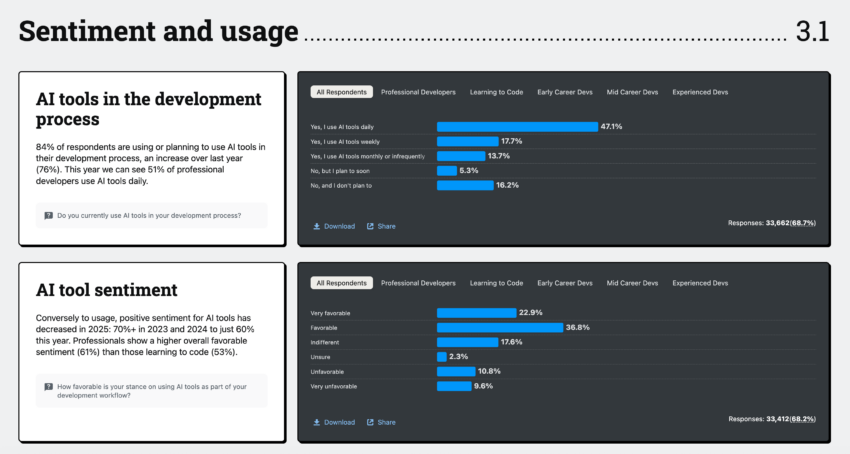Coinbase Charges Toward Majority AI-Generated Code as Global Adoption Accelerates
Coinbase isn't just trading digital assets—it's betting big on artificial intelligence to build them. The exchange now pushes toward majority AI-generated code, joining a seismic industry shift that's rewriting how tech gets made.
The New Development Paradigm
Forget traditional programming pipelines. Coinbase's engineering teams now leverage AI copilots that churn out functional code at unprecedented scale—cutting development cycles, bypassing manual testing bottlenecks, and deploying solutions before traditional teams even draft specs.
Why It Matters Beyond Crypto
This isn't just about one exchange. When a player of Coinbase's scale moves, entire sectors take notice. The global trend toward AI-assisted development accelerates, forcing competitors to adapt or get left debugging legacy systems while the AI train leaves the station.
The Bottom Line
Efficiency gains? Massive. Innovation speed? Blistering. Another case of tech solving tech's problems—while conveniently ignoring whether we actually need more financial products engineered by algorithms that probably dream in Python instead of profits. The code might be flawless, but the business model? Still human enough to leave room for error.
Armstrong’s Hardline on AI Adoption
Armstrong disclosed the target in a post on X, calling AI adoption a strategic imperative. The push follows months of internal programs to standardize the use of coding assistants, integrate new developer tools, and measure productivity with quantitative and qualitative metrics.
~40% of daily code written at Coinbase is AI-generated. I want to get it to >50% by October.
Obviously it needs to be reviewed and understood, and not all areas of the business can use AI-generated code. But we should be using it responsibly as much as we possibly can. pic.twitter.com/Nmnsdxgosp
“~40% of daily code written at Coinbase is AI-generated. I want to get it to >50% by October,” Armstrong wrote.
Coinbase’s commitment to AI has gone beyond voluntary experimentation. In a report, Armstrong explained that he mandated engineers to onboard to AI tools such as GitHub Copilot and Cursor. Employees who failed to comply were asked to justify their stance, and some were dismissed.
“AI’s important. We need you to all learn it and at least onboard,” Armstrong said, describing his decision to “go rogue” by bypassing longer rollout timelines.
Coinbase also hosts monthly “AI speedruns,” in which employees showcase practical applications of AI within their workflows. Armstrong said about one-third of the company’s code already comes from AI systems, and the target is to reach 50% before year-end.
Developer Productivity Framework
Coinbase detailed its strategy in an August 6 company blog. The post, authored by Kyle Cesmat and Chitra Venkatramani, outlined a framework built on DORA metrics and developer surveys. It emphasized responsible AI integration, noting that not all systems are suitable for code generation due to sensitivity and security considerations.
The company reported that more than 1,500 engineers use AI-powered tools daily, including IDE integrations and custom model routers.
Cursor has become the preferred integrated development environment for many engineers, though alternatives like Cody and JetBrains remain in use.
Coinbase tracks AI adoption through metrics such as lead-time-to-change, deployment frequency, and the share of AI-generated lines of code. The blog said AI output is “on track to eclipse human-generated code” by the end of the year.
Big Tech Leaders Highlight Similar Shifts
Coinbase’s trajectory reflects a broader trend among major technology companies. Google Chief Executive Sundar Pichai has said more than 25% of new code at the company is written by AI, describing it as a fundamental shift in software development.
Microsoft CEO Satya Nadella has gone further, stating that as much as 30% of the company’s code is AI-generated and predicting that proportion could rise to 50% within the next two years.
These figures illustrate how AI is no longer a fringe experiment but an essential productivity driver at the heart of enterprise technology strategies.
Research Confirms Global Adoption
Academic research supports these corporate disclosures. A 2025 study on arXiv examined millions of GitHub repositories and found that AI-generated code already accounts for 30.1% of functions in the United States, 24.3% in Germany, and 23.2% in France.
The study also estimated that productivity gains from AI-generated code could translate into $10 billion to $14 billion of additional annual economic value in the U.S. alone.
The analysis highlights a critical point: AI-driven development is not evenly distributed. Adoption is higher in advanced economies and technology hubs, while other regions trail behind.
Developers Report Daily Use
Surveys show the shift is felt strongly at the developer level. According to the Stack Overflow 2025 Developer Survey, 84% of respondents said they already use AI coding tools or plan to, and more than half reported daily usage. Notably, more than 40% of developers who use AI said at least half their codebase is now AI-generated.

Coinbase’s goal of surpassing 50% AI-generated code by October reflects a broader industry shift. From Silicon Valley to Europe, companies are embedding AI into development, reshaping the balance between human and machine contributions.
The challenge ahead is to boost productivity without compromising quality or security. As the company blog noted, “We are building a culture of innovation to make Coinbase the best place to build.”

